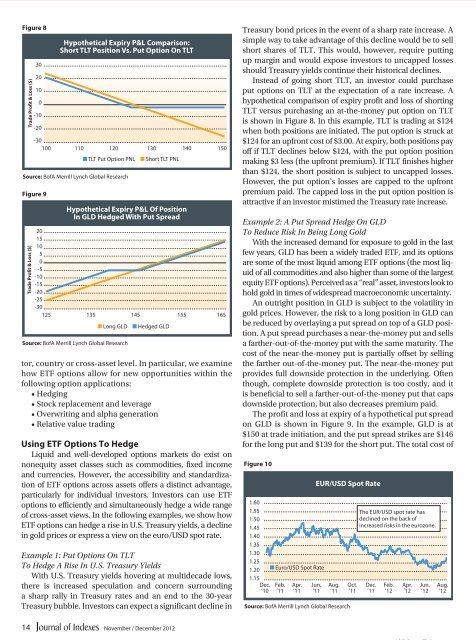Download complete issue - IndexUniverse.com
Download complete issue - IndexUniverse.com
Download complete issue - IndexUniverse.com
You also want an ePaper? Increase the reach of your titles
YUMPU automatically turns print PDFs into web optimized ePapers that Google loves.
Figure 8<br />
Trade Proft & Loss ($)<br />
Source: BofA Merrill Lynch Global Research<br />
Figure 9<br />
Trade Proft & Loss ($)<br />
30<br />
20<br />
10<br />
0<br />
-10<br />
-20<br />
Hypothetical Expiry P&L Comparison:<br />
Short TLT Position Vs. Put Option On TLT<br />
-30<br />
100 110 120 130 140 150<br />
Source: BofA Merrill Lynch Global Research<br />
■ TLT Put Option PNL ■ Short TLT PNL<br />
Hypothetical Expiry P&L Of Position<br />
In GLD Hedged With Put Spread<br />
20<br />
15<br />
10<br />
5<br />
0<br />
-5<br />
-10<br />
-15<br />
-20<br />
-25<br />
-30<br />
125 135 145 155 165<br />
■ Long GLD<br />
■ Hedged GLD<br />
tor, country or cross-asset level. In particular, we examine<br />
how ETF options allow for new opportunities within the<br />
following option applications:<br />
• Hedging<br />
• Stock replacement and leverage<br />
• Overwriting and alpha generation<br />
• Relative value trading<br />
Using ETF Options To Hedge<br />
Liquid and well-developed options markets do exist on<br />
nonequity asset classes such as <strong>com</strong>modities, fixed in<strong>com</strong>e<br />
and currencies. However, the accessibility and standardization<br />
of ETF options across assets offers a distinct advantage,<br />
particularly for individual investors. Investors can use ETF<br />
options to efficiently and simultaneously hedge a wide range<br />
of cross-asset views. In the following examples, we show how<br />
ETF options can hedge a rise in U.S. Treasury yields, a decline<br />
in gold prices or express a view on the euro/USD spot rate.<br />
Example 1: Put Options On TLT<br />
To Hedge A Rise In U.S. Treasury Yields<br />
With U.S. Treasury yields hovering at multidecade lows,<br />
there is increased speculation and concern surrounding<br />
a sharp rally in Treasury rates and an end to the 30-year<br />
Treasury bubble. Investors can expect a significant decline in<br />
Treasury bond prices in the event of a sharp rate increase. A<br />
simple way to take advantage of this decline would be to sell<br />
short shares of TLT. This would, however, require putting<br />
up margin and would expose investors to uncapped losses<br />
should Treasury yields continue their historical declines.<br />
Instead of going short TLT, an investor could purchase<br />
put options on TLT at the expectation of a rate increase. A<br />
hypothetical <strong>com</strong>parison of expiry profit and loss of shorting<br />
TLT versus purchasing an at-the-money put option on TLT<br />
is shown in Figure 8. In this example, TLT is trading at $124<br />
when both positions are initiated. The put option is struck at<br />
$124 for an upfront cost of $3.00. At expiry, both positions pay<br />
off if TLT declines below $124, with the put option position<br />
making $3 less (the upfront premium). If TLT finishes higher<br />
than $124, the short position is subject to uncapped losses.<br />
However, the put option’s losses are capped to the upfront<br />
premium paid. The capped loss in the put option position is<br />
attractive if an investor mistimed the Treasury rate increase.<br />
Example 2: A Put Spread Hedge On GLD<br />
To Reduce Risk In Being Long Gold<br />
With the increased demand for exposure to gold in the last<br />
few years, GLD has been a widely traded ETF, and its options<br />
are some of the most liquid among ETF options (the most liquid<br />
of all <strong>com</strong>modities and also higher than some of the largest<br />
equity ETF options). Perceived as a “real” asset, investors look to<br />
hold gold in times of widespread macroeconomic uncertainty.<br />
An outright position in GLD is subject to the volatility in<br />
gold prices. However, the risk to a long position in GLD can<br />
be reduced by overlaying a put spread on top of a GLD position.<br />
A put spread purchases a near-the-money put and sells<br />
a farther-out-of-the-money put with the same maturity. The<br />
cost of the near-the-money put is partially offset by selling<br />
the farther out-of-the-money put. The near-the-money put<br />
provides full downside protection in the underlying. Often<br />
though, <strong><strong>com</strong>plete</strong> downside protection is too costly, and it<br />
is beneficial to sell a farther-out-of-the-money put that caps<br />
downside protection, but also decreases premium paid.<br />
The profit and loss at expiry of a hypothetical put spread<br />
on GLD is shown in Figure 9. In the example, GLD is at<br />
$150 at trade initiation, and the put spread strikes are $146<br />
for the long put and $139 for the short put. The total cost of<br />
Figure 10<br />
1.60<br />
1.55<br />
1.50<br />
1.45<br />
1.40<br />
1.35<br />
1.30<br />
1.25<br />
1.20<br />
1.15<br />
Dec.<br />
’10<br />
■ Euro/USD Spot Rate<br />
Feb.<br />
’11<br />
Apr.<br />
’11<br />
EUR/USD Spot Rate<br />
Jun.<br />
’11<br />
Aug.<br />
’11<br />
Source: BofA Merrill Lynch Global Research<br />
Oct.<br />
’11<br />
The EUR/USD spot rate has<br />
declined on the back of<br />
increased risks in the eurozone.<br />
Dec.<br />
’11<br />
Feb.<br />
’12<br />
Apr.<br />
’12<br />
Jun.<br />
’12<br />
Aug.<br />
’12<br />
14<br />
November / December 2012
















